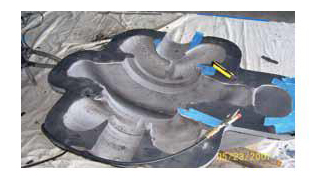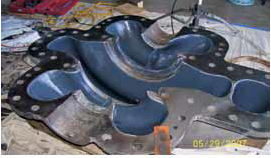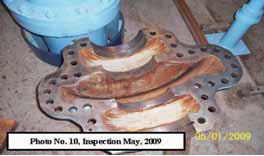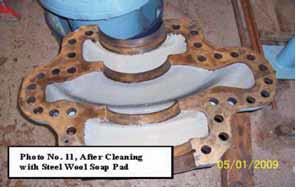The Restoration Process—Before and After
In the November 2010 issue of Pumps & Systems, this column began a two part series to analyze a study conducted on the Monroe County Water Authority (MCWA) in Rochester, N.Y., pump restoration project. As discussed in Part One, the restoration consisted of the mechanical refurbishment (replacement of wear rings, bearings and shaft sleeves), sandblasting, application of a metal filler (if required) and two coats of epoxy coating.Several types of coatings were considered for the project, but brushable, ceramic-filled epoxy coatings were the final choice for several reasons. The, MCWA wanted coatings that could be applied in-house without sophisticated tools. They also wanted coatings with good adhesion and abrasion characteristics. Finally, the coatings had to be NSF-61 approved and available at a reasonable cost. The coatings selected for the study were Henkel / Loctite Brushable Ceramic Grey, Belzona 1341 Supermetalglide and Enecon Chemclad XC.
 |
| Figure 1. The pump's internal condition before sandblasting |
Figure 1 shows a typical pump's internal condition prior to sandblasting. This particular pump is a 600 horsepower model that was installed in the mid 1980's. As shown, the interior exhibits both surface corrosion and tuberculation. Figure 2 shows a better view of the tuberculation. In certain areas of the casing and cover, tubers were larger than one-half inch.
Figure 2 shows the interior of the pump after sandblasting. After sandblasting, the surface was evaluated to determine if application of the metal filler was required prior to coating. This particular pump exhibited a significant amount of surface pitting, and those pits were filled prior to the coating process. Figure 3 shows the same pump after application of the metal filler and two coats of ceramic filled, epoxy coating.
 |
Figure 2. The pump casing after sandblasting |
 |
Figure 3. The interior after pit filling and two applications of epoxy coating |
Brush-On Coating Durability
As the project progressed, one of the most frequently asked questions was “how long will the coating last?” That question may not be fully answered for many years, but a greater understanding is achieved as time goes on.
MCWA tests all the pumps every six months to look for performance changes that could indicate premature coating failure. They also remove the upper casings annually and inspect the coating's integrity. This detailed monitoring continues to provide the information necessary to fully answer that question.
Figure 4 is an example of information gained by periodic visual inspection. It shows the interior of a pump cover after four years of operation. At first glance, it appeared that the coating was beginning to fail. However, upon closer examination, the discoloration was due to “rust staining.” The staining was caused by the rusting of a small part of uncoated machined surface between the upper and lower casing of the pump.
 |
| Figure 4. Rust staining initially thought the result of coating failure |
The coating remained smooth to the touch and did not flake off at its edges. After cleaning with a steel wool pad, (Figure 5) the coating returned to its original, post-coating appearance.
 |
Figure 5. Coating after four years of operation and rust stain removal |
Cost vs. Payback
Table 1 summarizes the restoration costs, energy savings and payback periods for all the pumps in the study. It assumes that the pumps operated nearly continuously prior to restoration. The energy savings are based on a demand charge of $10 per kilowatt and an energy charge of $0.085 per kilowatt hour.
As shown, the estimated total post restoration annual energy savings for all 16 pumps is $122,190 versus a total restoration cost of $101,461. The payback period ranges from 0.47 to 2.84 years, while the average for all pumps is 0.83 years. The total power reduction exceeded 1.3 million kilowatt hours.
.jpg) |
Table 1. Restoration cost, energy savings and payback period |
Relationship of Specific Speed and Efficiency Increase
A European study published in 2001 suggested that lower specific speed (Ns) pumps would show a greater increase in efficiency after coating than higher Ns pumps. MCWA's results showed a similar pattern. Pumps with an Ns between 1,000 and 1,200 saw an increase of about 12 percent while those between 2,000 and 2,500 increased by about 8 percent.
As the Ns approached 2,800, the increase dropped to about 5 percent, and at 3,900, the efficiency increase reached a low point of 2 percent. These results may be somewhat skewed since some of the pumps did not exhibit the same degree of roughness prior to restoration, and a roughness variable was not developed for the efficiency comparisons.
Project Conclusions and Recommendations
The MCWA's goal was to prevent or significantly delay the inevitable decline of pump performance due to internal corrosion. MCWA believes that it achieved its goal, and the conclusion is that restoration and coating offers multiple benefits including increased efficiency, head and flow. The study showed that sandblasting and coating resulted in higher initial and long-term efficiencies than sandblasting alone, and to date, the coatings have shown no signs of failure. MCWA recommends that new pumps be coated by the manufacturer or a coating vendor selected by the manufacturer prior to pump delivery. Internal coating is now a part of their [should this instead say “MCWA's”] specifications for new and replacement pumps.
This study involves much more than space allows. If you have questions or would like a copy of the complete WEFTEC presentation, please contact Paul Maier.
Pumps & Systems, December 2010

